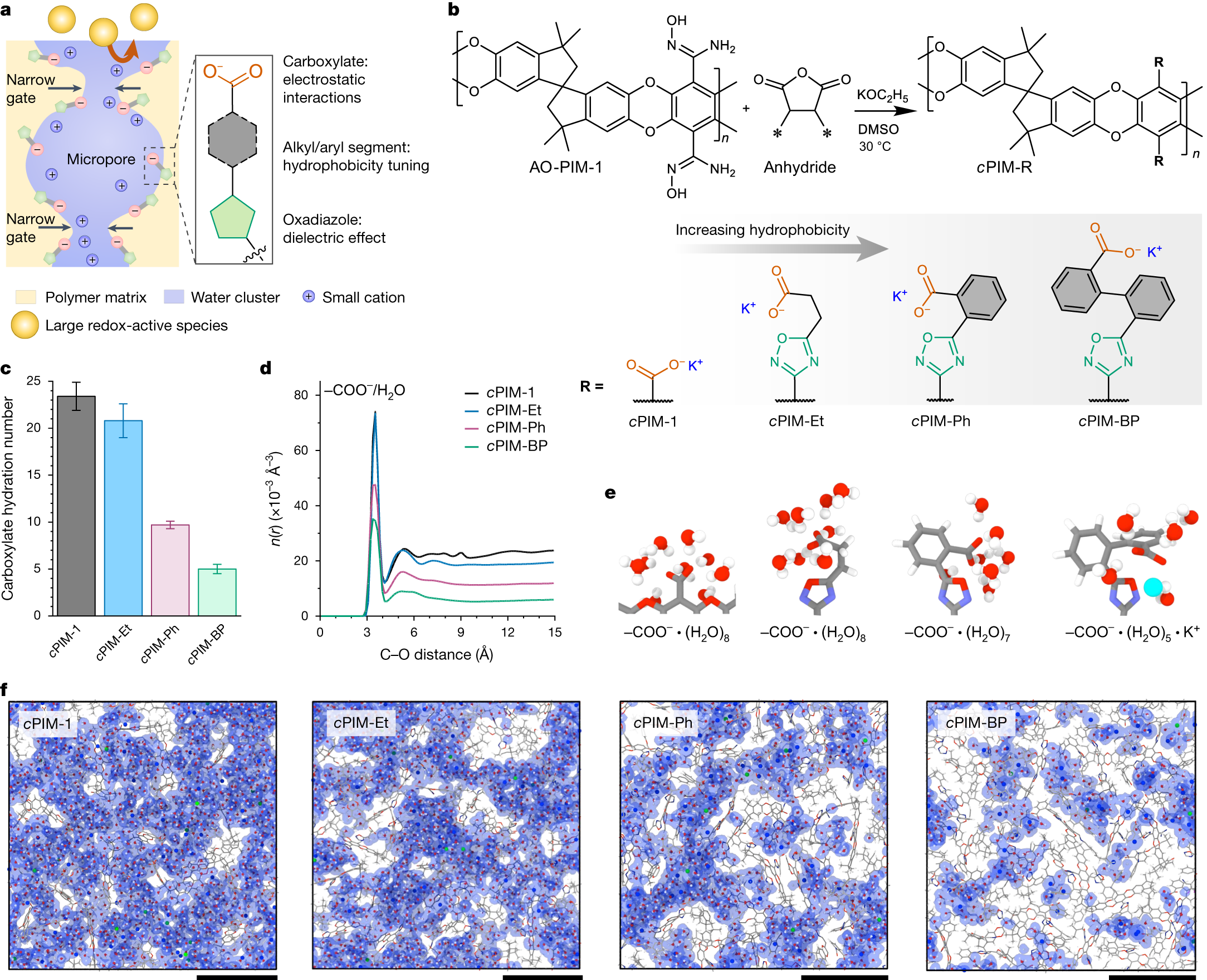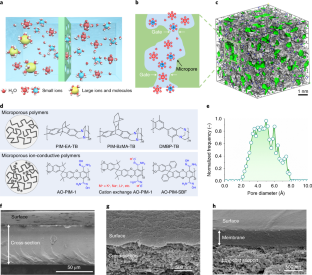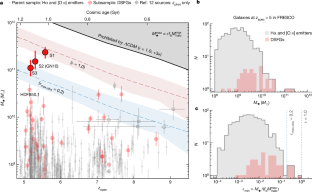2024-11-13 インペリアル・カレッジ・ロンドン(ICL)
<関連情報>
- https://www.imperial.ac.uk/news/258053/fine-tuning-exchange-membranes-better-energy-storage/
- https://www.nature.com/articles/s41586-024-08140-2
- https://www.nature.com/articles/s41563-019-0536-8
高分子膜の水和した微細孔を通る選択的イオン輸送 Selective ion transport through hydrated micropores in polymer membranes
Anqi Wang,Charlotte Breakwell,Fabrizia Foglia,Rui Tan,Louie Lovell,Xiaochu Wei,Toby Wong,Naiqi Meng,Haodong Li,Andrew Seel,Mona Sarter,Keenan Smith,Alberto Alvarez‐Fernandez,Mate Furedi,Stefan Guldin,Melanie M. Britton,Neil B. McKeown,Kim E. Jelfs & Qilei Song
Nature Published:06 November 2024
DOI:https://doi.org/10.1038/s41586-024-08140-2

Abstract
Ion-conducting polymer membranes are essential in many separation processes and electrochemical devices, including electrodialysis1, redox flow batteries2, fuel cells3 and electrolysers4,5. Controlling ion transport and selectivity in these membranes largely hinges on the manipulation of pore size. Although membrane pore structures can be designed in the dry state6, they are redefined upon hydration owing to swelling in electrolyte solutions. Strategies to control pore hydration and a deeper understanding of pore structure evolution are vital for accurate pore size tuning. Here we report polymer membranes containing pendant groups of varying hydrophobicity, strategically positioned near charged groups to regulate their hydration capacity and pore swelling. Modulation of the hydrated micropore size (less than two nanometres) enables direct control over water and ion transport across broad length scales, as quantified by spectroscopic and computational methods. Ion selectivity improves in hydration-restrained pores created by more hydrophobic pendant groups. These highly interconnected ion transport channels, with tuned pore gate sizes, show higher ionic conductivity and orders-of-magnitude lower permeation rates of redox-active species compared with conventional membranes, enabling stable cycling of energy-dense aqueous organic redox flow batteries. This pore size tailoring approach provides a promising avenue to membranes with precisely controlled ionic and molecular transport functions.
親水性微多孔膜による選択的イオン分離とフロー電池エネルギー貯蔵 Hydrophilic microporous membranes for selective ion separation and flow-battery energy storage
Rui Tan,Anqi Wang,Richard Malpass-Evans,Rhodri Williams,Evan Wenbo Zhao,Tao Liu,Chunchun Ye,Xiaoqun Zhou,Barbara Primera Darwich,Zhiyu Fan,Lukas Turcani,Edward Jackson,Linjiang Chen,Samantha Y. Chong,Tao Li,Kim E. Jelfs,Andrew I. Cooper,Nigel P. Brandon,Clare P. Grey,Neil B. McKeown & Qilei Song
Nature Materials Published:02 December 2019
DOI:https://doi.org/10.1038/s41563-019-0536-8
An Author Correction to this article was published on 22 December 2019
This article has been updated

Abstract
Membranes with fast and selective ion transport are widely used for water purification and devices for energy conversion and storage including fuel cells, redox flow batteries and electrochemical reactors. However, it remains challenging to design cost-effective, easily processed ion-conductive membranes with well-defined pore architectures. Here, we report a new approach to designing membranes with narrow molecular-sized channels and hydrophilic functionality that enable fast transport of salt ions and high size-exclusion selectivity towards small organic molecules. These membranes, based on polymers of intrinsic microporosity containing Tröger’s base or amidoxime groups, demonstrate that exquisite control over subnanometre pore structure, the introduction of hydrophilic functional groups and thickness control all play important roles in achieving fast ion transport combined with high molecular selectivity. These membranes enable aqueous organic flow batteries with high energy efficiency and high capacity retention, suggesting their utility for a variety of energy-related devices and water purification processes.



